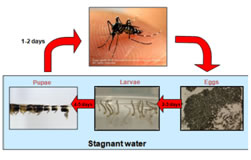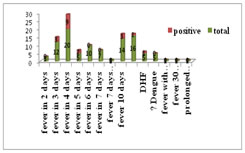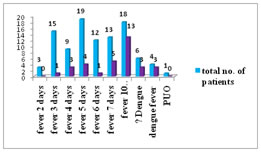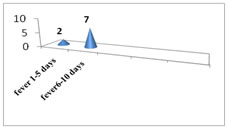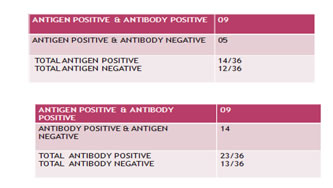Official Journals By StatPerson Publication
|
Table of Content Volume 11 Issue 2 - August 2019
Early detection of dengue by ELISA based method in a tertiary care hospital
B S G Sailaja1, M Suneetha Rani2*
1Assistant Professor, Department of Microbiology, GSL Medical College, Rajahmundry, Andhra Pradesh, INDIA. 2Department of Microbiology, Visakhapatnam, Andhra Pradesh, INDIA. Email: bgsailaja@gmail.com
Abstract Accurate and early diagnosis of dengue is important for timely detection of dengue virus infection. The study is aimed to detect the dengue in early stages by using NS1 antigen and IgM antibody as a rapid diagnostic tool. A total of 101Serum samples for the detection NS1 Ag and 108 serum samples for the detection IgM Ab of dengue virus infection were collected. These samples were tested for NS1 antigen and IgM antibody using ELISA kit separately. Out of 101samples, 19were positive for NS1.Out of108 samples, 33were positive for IgM. Of 101 and 108 samples 36were positive for both. The results reveal that the adopted ELISA method is suitable for the early detection of dengue and could increase the diagnostic efficiency for early diagnosis. Key Word: Dengue virus, IgM, ELISA, Antibodies, Infection.
INTRODUCTION Dengue virus infection- a mosquito borne disease caused by single stranded positive sense RNA virus belonging to flaviviridae family. It is an emerging disease of both tropical and subtropical regions. The disease is endemic in more than 90countries in Southern Asia and America, Eastern Mediterranean, western pacific and Africa, threatening billions of mankind1. This rapid emergence of disease leads to thousands of deaths worldwide with the increasing incidence and spread of disease. The virus encodes five distinct antigenically related serotypes that produce a spectrum of clinical illness ranging from fever to fatal illness, dengue shock syndrome and haemorrhagic fever. The disease is graded according to its severity and clinical features include fever, muscle and joint pain, head ache, nausea, vomiting and haemorrhagic manifestations. Some other population based studies suggest that asymptomatic infections are the major outcomes of dengue virus exposure.2,3 As the disease is progressing fast with or without symptoms, laboratory diagnosis using rapid, accurate and cost effective tests is important4. Diagnostic laboratories of many developing countries lack the facilities of dengue diagnosis; there after it is mandatory to detect dengue in early stages by using NS1 antigen and IGM antibody. The timely diagnosis is required in reducing the risk of complications occurred by dengue virus especially in dengue prone countries. Aedes aegypti is a dark coloured, small size mosquito with banded legs and lyre shaped markings. It is found frequently in tropical and subtropical regions of world and is historically considered as a primary vector for viral diseases like dengue, chikungunya and yellow fever. It usually bites during the day and lay their eggs on storage containers, these eggs have ability to survive longer periods and to spread to new locations5. Life cycle of Aedes Mosquito: NS 1 ANTIGEN is a non-structural protein introduced in the year 2006 which allows rapid detection on the very first day of fever before the appearance of antibodies by the help of enzyme- linked immunosorbent assay. Dengue virus has five serotypes (DEN 1,2,3,4,5) out of which 3 major are NS proteins (NS 1, NS 3, NS 5) found in flavivirus infected cells. NS 1 is a glycoprotein which is essential for virus viability involved in viral replication morphogenesis. It is found in the blood stream of a large number of patients tested during the acute infection.6 IgM antibody is the largest group of antibodies that are produced by vertebrates. It represents first in response to initial exposure to an antigen. The presence of these IgM antibodies indicates a primary and recent infection and detection of these antibodies will help in early diagnosis of dengue. Hence, the aim and objective of the present study is primarily to detect NS1 antigen and IgM antibody in patients for the early diagnosis of dengue. Secondly to offer most sensitive diagnostic modality of dengue this allows earlier implementation of supportive therapy and monitoring the risk of complications like Dengue haemorrhagic fever.
METHODS AND MATERIALS This study was conducted in Department of Microbiology, Rangaraya Medical College, and Andhra Pradesh, India. The study was cleared by institute ethics committee and informed consent was collected from patients. During the study period, 101 Serum samples for NS1 detection and 108 serum samples for IgM Ab were processed from clinically suspected dengue patients were collected at Govt. General Hospital Rangaraya medical college, India. All the samples were tested for antidengue IGM antibodies and NS1 antigen detection by ELISA. The kits were procured from National Institute of Virology, Pune. A panel of 101 and 108 Serum samples was collected for conducting this study. RESULTS Out of 101 cases, 19 (23%) were positive for NS1 antigen during the first five days of fever. Out of 108 cases, 33(30%) were positive for IgM antibody between fifth to tenth day of fever. Of the 36 cases, 09 (25%) were positive for both for NS1 antigen and IgM antibody during 6 to 10 days of fever. The results were tabulated from Table 1 to Table 6. Of 19(23%) positives in antigen, 09 were in fever with 4 days at D.F 4; P<0.015 Figure 1: Detection of NS1 Ag positives in different days of onset of fever Of 33(30%) positives in antibody, 13 were in fever with 10 days and TCP at D.F 4; P<0.001 Figure 2: Detection of IgM positives in different days of onset of fever Of 36 cases 9 were positive for antigen and antibody at D.F 1; P<0.003 Figure 3: showing cases positive for both NS1Ag and IgM Ab Of 36 cases 7 were positive (20%) at fever 6-10 days at DF 1; P<0.004 Figure 4: showing onset of fever of cases positive for NS1Ag and IgM Ab Figure 5 and 6: the above tables showing both Ag and Ab positives, only Ag Positives, Only Ag Negatives, Only Ab Positives, Only Ab Negatives DISCUSSION Dengue virus is single-stranded RNA virus that belongs to Flaviviridae family and genus Flavi virus. There are other important vector-borne viruses in the same family which include yellow fever virus, St.Louis encephalitis virus etc. Majorly, dengue virus is transmitted basically to humans through the bite of Aedes mosquito. The route of transmission is through infected blood or as exposure in health care systems like needles and cases of vertical transmission7. Over the past 50 years, it was noticed an increase in the incidence of dengue 30-fold worldwide, largely as a consequence of migration in population, increased travel, poor vector control measures8. In India, serological tests using rapid kits are most commonly used for dengue diagnosis. The use of ELISA facilities was not easily available at most of the diagnostic centres and use of other diagnostic kits was available in the market without regulation by National and International testing authorities. This has drawn a concerning lack of independent verification of diagnostic accuracy claimed by manufacturers, which could lead to misdiagnosis of dengue infection. The majority of the cases tested in the study demonstrated for IgM detection, range and the specificity was generally higher and more consistent. Dengue viremia and antibody response patterns are most readily used for laboratory diagnosis of dengue virus infection. The degree of viremia have implications for case management, as the peak of dengue viremia appears early in the febrile phase which shown to correlate with the disease severity. Detection of NS 1 Ag and IgM antibody has been the mainstay of diagnosis of dengue infection9. NS 1 appears prior to seroconversion and is detectable from day 1 to day 6 which is shown to be highly specific viral marker making it extremely reliable for diagnosis of Dengue infection from day 1 of fever. Detection of this NS 1 Ag and IgM antibody has become the primary diagnosis criteria for dengue infection and appears prior to seroconversion10. In our study NS1 and IgM combination out of 36 cases, 9 (25%) were positive. The assessment of NS1 Ag with IgM detection assays a diagnostic tool across a wide range of patient populations and plays a significant part in identifying the infection. NS1 is found highly conserved for all serotypes, circulating in high levels during the first few days of illness and correlates with the development of DHF. IgM antibody appears from 5th day and persists for 2 months. NS 1 Ag and IgM Ab detection by ELISA are potentially useful tests during early febrile stage (11). Detection of NS1 antigen is a diagnostic marker for dengue infection during the early phase of infection and serves as a prognostic marker of disease progression (12).NS1 antigen and specific IgM antibody evidences a recent acute infection with dengue virus.NS1 antigen in combination with IgM antibody assay offers the most sensitive diagnostic modality of dengue. Out of 36 cases the overall positivity for both Ag-Ab were 9, Ag were 5, Ab were 14, Ag-Ab negative 8, The sensitivity was 39.1%; specificity 38.4%, Positive predictive value 64.2%, Negative predictive value 36.3%.
CONCLUSION Dengue infection, the most common in developing countries leads to illness and deaths. Hence, there is an urgent need for early diagnosis of this fatal infection, therefore in the present study, the detection of NS1 antigen was made along with IgM antibody and the results showed potent specificity for both. Interestingly, present finding suggest that ELISA used for detecting NS1 antigen became useful specific tool for the diagnosis of acute dengue infection. Hence, the combined use of NS1 antigen with dengue IgM test could significantly enhance diagnosis of infection. With this inference, the rate of morbidity and mortality can be reduced by adopting serological tests that plays a significant role in early diagnosis of dengue
REFERENCES
|
|
 Home
Home
